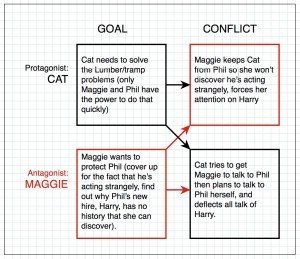How many times have I said, “Write the first scene last”? “You can’t know how a book begins until you know how it ends.” “Don’t waste your time rewriting the first scene over and over again, you’re going to change when the book is finished anyway.”
So I’ve spent the last week rewriting the first scene. Hell, I’ve spent the last three months rewriting this first scene.
In my head, in the computer, on paper, I’ve done everything but draw it on the ceiling, although I’m not ruling that out. The thing is, this is a collaboration, and Toni has the next scene, so I can’t just blithely say, “Oh, I’ll do that at the end.” Her first scene is set in the same time and place. And this book is so complex I actually do need that first scene in place roughly the way it will be in the finished book.
The first pass was that mess that you all rightly loathed. Then Toni pointed out that it started too late in the story, that she needed an extra half hour before that. I wrote the half hour before that which was mostly Cat thinking and chatting. So that had to go. Then Toni said, “How about starting with the Cat and Harry scene” which is a much better scene that starts about half an hour after the fireball. So I tried that, but shoehorning in the necessary info from the first scene just wrecked a perfectly good scene, so I went back to starting half an hour before the fireball.
At that point, Toni and I discussed whether we needed the fireball. Honestly, we do have a grip on this story, it’s just this freaking first scene . . .
We decided we needed the fireball, it just had to be smaller. A detail, not an event. Back to the beginning. Which had to introduce Cat, Keely, Pansy, Maggie, Harry, Phil, and several other characters. Had to establish Cat’s problems which were many. Had to be structured on the conflict with Maggie. Had to have description because you guys are so picky. (And Toni. Toni wanted description.) At about my fortieth rewrite, I thought, “ARGH TOO MUCH,” but I’m stuck. This stuff has to go in there.
So I’m going back to the basics.
Who’s the protagonist? Cat
What does she want? To solve the problems that are dis-ordering her safe world.
Who’s the antagonist? Maggie
What does she want? To concentrate on the threat she perceive to the man she loves while ignoring the fact that he’s not taking care of the problems Cat’s worrying about.
Is there a conflict lock?

Kinda.
So if I use Cat and Maggie struggling over Phil as the spine, then I can use the Keely and Pansy interruptions as complications. Plus there’s description.
All I need is about twenty-six Diet Cokes and some graph paper and I can solve this. I know I can.
ARGH.
Back later.

 newest »
newest »
 newest »
newest »
 The same rule is true of non-fiction writing - articles and books. Write the beginning last. Which makes me wonder if another non-fiction rule could help you here. The rule is: in cases of intro hardship, when nothing else will work, write your way into it. Just write whatever you need to to get to the story - often it's kinda dull to read but it's what you need to get there. Then set it aside for a bit. Then return and slash off the first several paragraphs. Kind of like snapping off the ends of asparagus where they naturally want to snap to get to the good stuff.
The same rule is true of non-fiction writing - articles and books. Write the beginning last. Which makes me wonder if another non-fiction rule could help you here. The rule is: in cases of intro hardship, when nothing else will work, write your way into it. Just write whatever you need to to get to the story - often it's kinda dull to read but it's what you need to get there. Then set it aside for a bit. Then return and slash off the first several paragraphs. Kind of like snapping off the ends of asparagus where they naturally want to snap to get to the good stuff.




